Phospholipid composition and longevity: lessons from Ames dwarf mice
- PMID: 23640425
- PMCID: PMC3825011
- DOI: 10.1007/s11357-013-9533-z
Phospholipid composition and longevity: lessons from Ames dwarf mice
Abstract
Membrane fatty acid (FA) composition is correlated with longevity in mammals. The "membrane pacemaker hypothesis of ageing" proposes that animals which cellular membranes contain high amounts of polyunsaturated FAs (PUFAs) have shorter life spans because their membranes are more susceptible to peroxidation and further oxidative damage. It remains to be shown, however, that long-lived phenotypes such as the Ames dwarf mouse have membranes containing fewer PUFAs and thus being less prone to peroxidation, as would be predicted from the membrane pacemaker hypothesis of ageing. Here, we show that across four different tissues, i.e., muscle, heart, liver and brain as well as in liver mitochondria, Ames dwarf mice possess membrane phospholipids containing between 30 and 60 % PUFAs (depending on the tissue), which is similar to PUFA contents of their normal-sized, short-lived siblings. However, we found that that Ames dwarf mice membrane phospholipids were significantly poorer in n-3 PUFAs. While lack of a difference in PUFA contents is contradicting the membrane pacemaker hypothesis, the lower n-3 PUFAs content in the long-lived mice provides some support for the membrane pacemaker hypothesis of ageing, as n-3 PUFAs comprise those FAs being blamed most for causing oxidative damage. By comparing tissue composition between 1-, 2- and 6-month-old mice in both phenotypes, we found that membranes differed both in quantity of PUFAs and in the prevalence of certain PUFAs. In sum, membrane composition in the Ames dwarf mouse supports the concept that tissue FA composition is related to longevity.
Figures
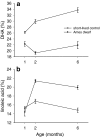
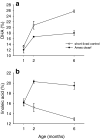
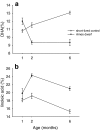
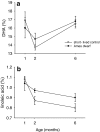
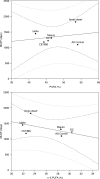
Similar articles
-
Feeding into old age: long-term effects of dietary fatty acid supplementation on tissue composition and life span in mice.J Comp Physiol B. 2011 Feb;181(2):289-98. doi: 10.1007/s00360-010-0520-8. Epub 2010 Oct 28. J Comp Physiol B. 2011. PMID: 20981551 Free PMC article.
-
Of mice, pigs and humans: An analysis of mitochondrial phospholipids from mammals with very different maximal lifespans.Exp Gerontol. 2015 Oct;70:135-43. doi: 10.1016/j.exger.2015.08.011. Epub 2015 Aug 24. Exp Gerontol. 2015. PMID: 26315290
-
Membrane phospholipid composition may contribute to exceptional longevity of the naked mole-rat (Heterocephalus glaber): a comparative study using shotgun lipidomics.Exp Gerontol. 2007 Nov;42(11):1053-62. doi: 10.1016/j.exger.2007.09.004. Exp Gerontol. 2007. PMID: 18029129
-
Methionine flux to transsulfuration is enhanced in the long living Ames dwarf mouse.Mech Ageing Dev. 2006 May;127(5):444-50. doi: 10.1016/j.mad.2006.01.001. Epub 2006 Mar 6. Mech Ageing Dev. 2006. PMID: 16519922 Free PMC article. Review.
-
Functionally enhanced brown adipose tissue in Ames dwarf mice.Adipocyte. 2017 Jan 2;6(1):62-67. doi: 10.1080/21623945.2016.1274470. Epub 2016 Dec 21. Adipocyte. 2017. PMID: 28452585 Free PMC article. Review.
Cited by
-
Sarcolemmal dependence of cardiac protection and stress-resistance: roles in aged or diseased hearts.Br J Pharmacol. 2016 Oct;173(20):2966-91. doi: 10.1111/bph.13552. Epub 2016 Sep 9. Br J Pharmacol. 2016. PMID: 27439627 Free PMC article. Review.
-
Alterations of Lipid Metabolism With Age and Weight in Companion Dogs.J Gerontol A Biol Sci Med Sci. 2021 Feb 25;76(3):400-405. doi: 10.1093/gerona/glaa186. J Gerontol A Biol Sci Med Sci. 2021. PMID: 32750116 Free PMC article.
-
Cutting back on the essentials: Can manipulating intake of specific amino acids modulate health and lifespan?Ageing Res Rev. 2017 Oct;39:87-95. doi: 10.1016/j.arr.2016.08.007. Epub 2016 Aug 26. Ageing Res Rev. 2017. PMID: 27570078 Free PMC article. Review.
-
Healthy n-6/n-3 fatty acid composition from five European game meat species remains after cooking.BMC Res Notes. 2015 Jun 27;8:273. doi: 10.1186/s13104-015-1254-1. BMC Res Notes. 2015. PMID: 26116375 Free PMC article.
-
Integrated metabolomics reveals altered lipid metabolism in adipose tissue in a model of extreme longevity.Geroscience. 2020 Dec;42(6):1527-1546. doi: 10.1007/s11357-020-00221-0. Epub 2020 Jul 6. Geroscience. 2020. PMID: 32632845 Free PMC article.
References
Publication types
MeSH terms
Substances
Grants and funding
LinkOut - more resources
Full Text Sources
Other Literature Sources
Medical
Research Materials
Miscellaneous
